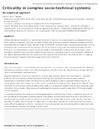Identificador persistente para citar o vincular este elemento:
https://accedacris.ulpgc.es/jspui/handle/10553/52257
| Campo DC | Valor | idioma |
|---|---|---|
| dc.contributor.author | Viejo, Pablo | en_US |
| dc.contributor.author | de Durana, José González | en_US |
| dc.contributor.author | Barambones, Óscar | en_US |
| dc.contributor.author | Hernández-Tejera, Francisco Mario | en_US |
| dc.contributor.author | Hernández Cabrera, José Juan | en_US |
| dc.contributor.author | Évora Gómez, José | en_US |
| dc.contributor.author | Kremers, Enrique | en_US |
| dc.date.accessioned | 2018-11-25T18:46:22Z | - |
| dc.date.available | 2018-11-25T18:46:22Z | - |
| dc.date.issued | 2015 | en_US |
| dc.identifier.issn | 1521-3250 | en_US |
| dc.identifier.uri | https://accedacris.ulpgc.es/handle/10553/52257 | - |
| dc.description.abstract | Critical regimes are present in all socio-technical systems. Usually, man-made systems are designed to avoid these regimes completely, and stay in a stable steady state to avoid uncertainty. However, complexity theory postulates that the edge of chaos, between order and disorder, provides highly interesting phenomena, such as emergence, which are important for the evolution of the system. In this paper we explore the edge of chaos through a concrete example in electrical energy systems. The exploration is done through simulation, which provides a valuable mean to perform massive experiments on large scale systems. The complexity residing at the edge is discussed, and external, system relevant and internal factors which are likely to shift this edge or drive the systems trajectory towards or away from it are introduced. | en_US |
| dc.language | eng | en_US |
| dc.relation.ispartof | Emergence: Complexity and Organization | en_US |
| dc.source | Emergence : Complexity and Organization [ISSN 1521-3250], v. 17 (2), p. 1-8 | en_US |
| dc.subject | 1203 Ciencia de los ordenadores | en_US |
| dc.title | Criticality in complex socio-technical systems. An empirical approach | en_US |
| dc.type | info:eu-repo/semantics/Article | en_US |
| dc.type | Article | en_US |
| dc.identifier.scopus | 84957900872 | - |
| dc.contributor.authorscopusid | 36142520000 | - |
| dc.contributor.authorscopusid | 35787077400 | - |
| dc.contributor.authorscopusid | 57112284300 | - |
| dc.contributor.authorscopusid | 6602401604 | - |
| dc.contributor.authorscopusid | 7801415156 | - |
| dc.contributor.authorscopusid | 56109424300 | - |
| dc.contributor.authorscopusid | 57111316900 | - |
| dc.contributor.authorscopusid | 36141961500 | - |
| dc.description.lastpage | 8 | en_US |
| dc.description.firstpage | 1 | en_US |
| dc.relation.volume | 17 | en_US |
| dc.investigacion | Ingeniería y Arquitectura | en_US |
| dc.type2 | Artículo | en_US |
| dc.utils.revision | Sí | en_US |
| dc.date.coverdate | Junio 2015 | en_US |
| dc.identifier.ulpgc | Sí | en_US |
| dc.description.sjr | 0,257 | |
| dc.description.sjrq | Q3 | |
| dc.description.esci | ESCI | |
| item.grantfulltext | open | - |
| item.fulltext | Con texto completo | - |
| crisitem.author.dept | GIR SIANI: Inteligencia Artificial, Redes Neuronales, Aprendizaje Automático e Ingeniería de Datos | - |
| crisitem.author.dept | IU Sistemas Inteligentes y Aplicaciones Numéricas | - |
| crisitem.author.dept | Departamento de Informática y Sistemas | - |
| crisitem.author.dept | GIR SIANI: Inteligencia Artificial, Redes Neuronales, Aprendizaje Automático e Ingeniería de Datos | - |
| crisitem.author.dept | IU Sistemas Inteligentes y Aplicaciones Numéricas | - |
| crisitem.author.dept | Departamento de Informática y Sistemas | - |
| crisitem.author.dept | GIR SIANI: Inteligencia Artificial, Redes Neuronales, Aprendizaje Automático e Ingeniería de Datos | - |
| crisitem.author.dept | IU Sistemas Inteligentes y Aplicaciones Numéricas | - |
| crisitem.author.dept | Departamento de Informática y Sistemas | - |
| crisitem.author.orcid | 0000-0001-9717-8048 | - |
| crisitem.author.orcid | 0000-0003-2427-2441 | - |
| crisitem.author.orcid | 0000-0001-9348-7265 | - |
| crisitem.author.parentorg | IU Sistemas Inteligentes y Aplicaciones Numéricas | - |
| crisitem.author.parentorg | IU Sistemas Inteligentes y Aplicaciones Numéricas | - |
| crisitem.author.parentorg | IU Sistemas Inteligentes y Aplicaciones Numéricas | - |
| crisitem.author.fullName | Hernández Tejera, Francisco Mario | - |
| crisitem.author.fullName | Hernández Cabrera, José Juan | - |
| crisitem.author.fullName | Évora Gómez, José | - |
| Colección: | Artículos | |
Citas SCOPUSTM
2
actualizado el 08-jun-2025
Visitas
119
actualizado el 12-ene-2025
Descargas
85
actualizado el 12-ene-2025
Google ScholarTM
Verifica
Comparte
Exporta metadatos
Los elementos en ULPGC accedaCRIS están protegidos por derechos de autor con todos los derechos reservados, a menos que se indique lo contrario.
